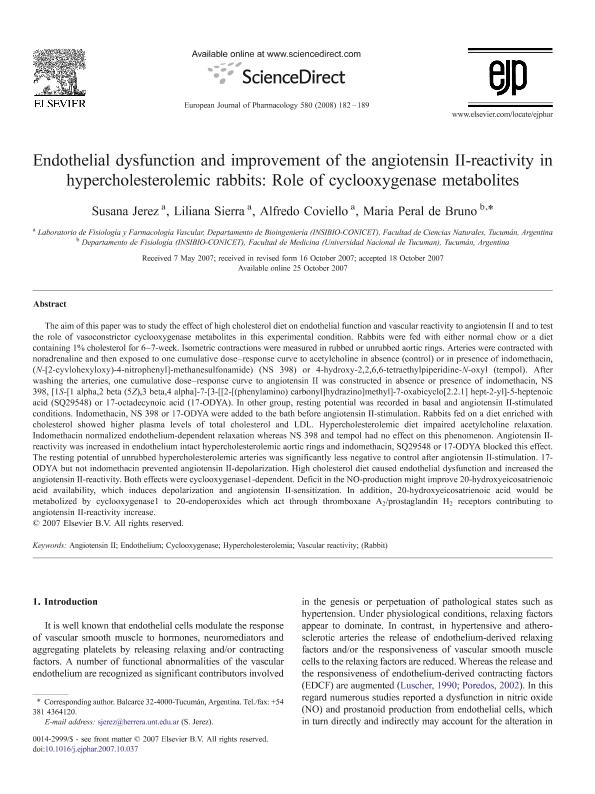Artículo
Endothelial dysfunction and improvement of the angiotensin II-reactivity in hypercholesterolemic rabbits: Role of cyclooxygenase metabolites
Fecha de publicación:
02/2008
Editorial:
Elsevier Science
Revista:
European Journal of Pharmacology
ISSN:
0014-2999
Idioma:
Inglés
Tipo de recurso:
Artículo publicado
Clasificación temática:
Resumen
The aim of this paper was to study the effect of high cholesterol diet on endothelial function and vascular reactivity to angiotensin II and to test the role of vasoconstrictor cyclooxygenase metabolites in this experimental condition. Rabbits were fed with either normal chow or a diet containing 1% cholesterol for 6-7-week. Isometric contractions were measured in rubbed or unrubbed aortic rings. Arteries were contracted with noradrenaline and then exposed to one cumulative dose-response curve to acetylcholine in absence (control) or in presence of indomethacin, (N-[2-cyvlohexyloxy)-4-nitrophenyl]-methanesulfonamide) (NS 398) or 4-hydroxy-2,2,6,6-tetraethylpiperidine-N-oxyl (tempol). After washing the arteries, one cumulative dose-response curve to angiotensin II was constructed in absence or presence of indomethacin, NS 398, [1S-[1 alpha,2 beta (5Z),3 beta,4 alpha]-7-[3-[[2-[(phenylamino) carbonyl]hydrazino]methyl]-7-oxabicyclo[2.2.1] hept-2-yl]-5-heptenoic acid (SQ29548) or 17-octadecynoic acid (17-ODYA). In other group, resting potential was recorded in basal and angiotensin II-stimulated conditions. Indomethacin, NS 398 or 17-ODYA were added to the bath before angiotensin II-stimulation. Rabbits fed on a diet enriched with cholesterol showed higher plasma levels of total cholesterol and LDL. Hypercholesterolemic diet impaired acetylcholine relaxation. Indomethacin normalized endothelium-dependent relaxation whereas NS 398 and tempol had no effect on this phenomenon. Angiotensin II-reactivity was increased in endothelium intact hypercholesterolemic aortic rings and indomethacin, SQ29548 or 17-ODYA blocked this effect. The resting potential of unrubbed hypercholesterolemic arteries was significantly less negative to control after angiotensin II-stimulation. 17-ODYA but not indomethacin prevented angiotensin II-depolarization. High cholesterol diet caused endothelial dysfunction and increased the angiotensin II-reactivity. Both effects were cyclooxygenase1-dependent. Deficit in the NO-production might improve 20-hydroxyeicosatrienoic acid availability, which induces depolarization and angiotensin II-sensitization. In addition, 20-hydroxyeicosatrienoic acid would be metabolized by cyclooxygenase1 to 20-endoperoxides which act through thromboxane A2/prostaglandin H2 receptors contributing to angiotensin II-reactivity increase.
Archivos asociados
Licencia
Identificadores
Colecciones
Articulos(INSIBIO)
Articulos de INST.SUP.DE INVEST.BIOLOGICAS
Articulos de INST.SUP.DE INVEST.BIOLOGICAS
Citación
Jerez, Susana Josefina; Sierra, Liliana Beatríz; Coviello, Alfredo; Peral, Maria de Los Angeles; Endothelial dysfunction and improvement of the angiotensin II-reactivity in hypercholesterolemic rabbits: Role of cyclooxygenase metabolites; Elsevier Science; European Journal of Pharmacology; 580; 1-2; 2-2008; 182-189
Compartir
Altmétricas




